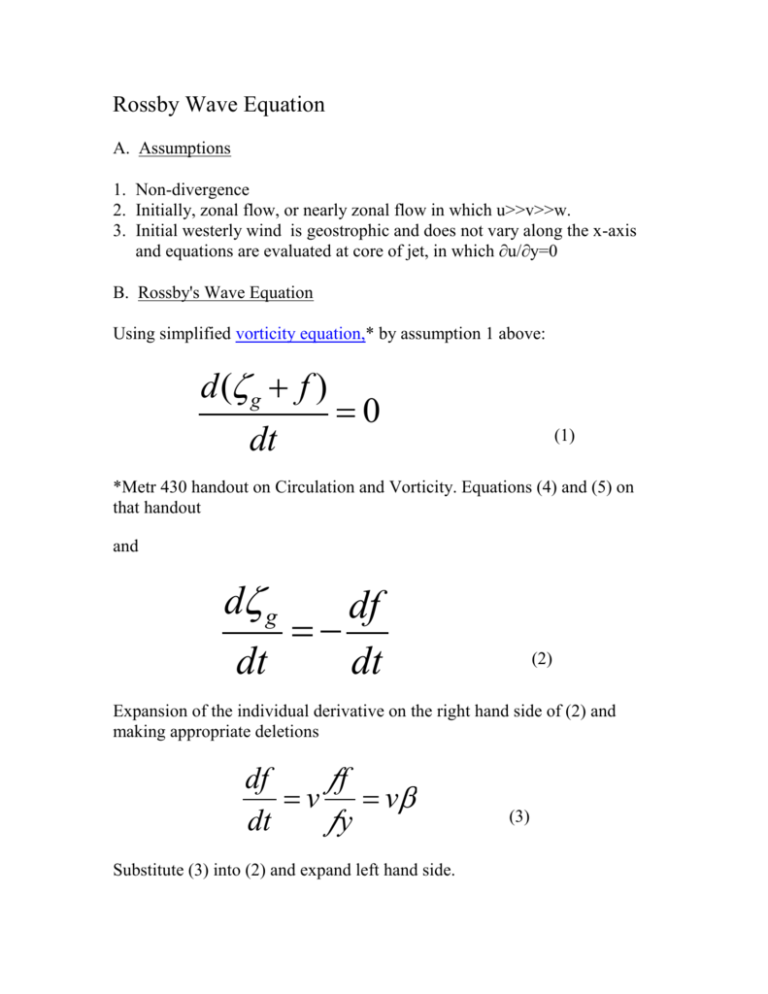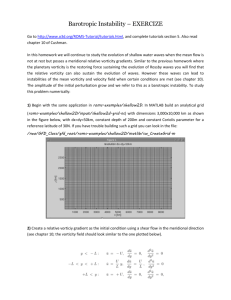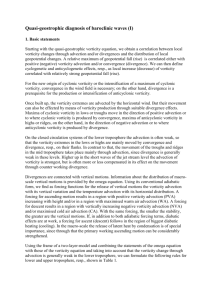Rossby`s Wave Equation and Constant Absolute Vorticity Trajectories
advertisement

Rossby Wave Equation A. Assumptions 1. Non-divergence 2. Initially, zonal flow, or nearly zonal flow in which u>>v>>w. 3. Initial westerly wind is geostrophic and does not vary along the x-axis and equations are evaluated at core of jet, in which ∂u/∂y=0 B. Rossby's Wave Equation Using simplified vorticity equation,* by assumption 1 above: d(z g + f ) dt =0 (1) *Metr 430 handout on Circulation and Vorticity. Equations (4) and (5) on that handout and dz g df =dt dt (2) Expansion of the individual derivative on the right hand side of (2) and making appropriate deletions df ¶f = v = vb dt ¶y Substitute (3) into (2) and expand left hand side. (3) ¶z g ¶z g ¶z g ¶z g + ug + vg +w = -vb (4) ¶t ¶x ¶y ¶z By assumption 2 above, the products of v and w with the gradients of relative vorticity can be neglected on an order of magnitude basis. ¶z g ¶z g + ug = -vb ¶t ¶x (5) At the level of non-divergence, the wind tends to be of the same order of magnitude as the motion of the wave patterns. Thus, most to all of the local changes vorticity will be due to the translation of existing vorticity patterns This is expressed in equation (6). ¶z g ¶z g » -c ¶t ¶x (6) Put (5) and (6) into (4) ¶z g (ug - c) ¶ x = -vb (7) The definition of relative vorticity is z = æè ¶v ¶x - ¶u ¶yöø By assumption 3 above 2 (8) ¶u ¶y = 0 (9) dropping and understanding that by assumption (3) the real wind is approximated by the geostrophic wind (subscript is now dropped) and inserting (9) into (8) and the transformed (8) into (7) 2 ¶ ( u - c) v ¶x 2 + vb = 0 (10) Equation (10) is a d ifferential equation with solution of form y = Asin 2p ( x - ct ) L (11a) or for a given air parcel moving with a constant u and for a wave moving with a constant phase speed x - ct v = Acos2p ( ) L (11b) where A is amplitude, L is wavelength and c is phase speed of the wave. C. Constant Absolute Vorticity Trajectories Equation (11b) states that as an air parcel moves along the x axis (i.e., changes its longitude) a v-component can be obtained for every location on 3 the x-axis along the parcel’s path. In other words, a v can be obtained for each location along the x-axis. If each vector is so plotted and connected with a line, the parcel’s trajectory, termed, Constant Absolute Vorticity Trajectory, can be drawn. Integration of (11) shows that such trajectories are sinusoidal. Constant Absolute Vorticity (CAV) trajectories are so-named because on the way to arriving at equations (10) and (11), Rossby assumed that the absolute vorticity of air parcels is conserved, as explained above and in class. There is great danger in assuming that CAV trajectories explain the general form of long waves. The long wave pattern really is constructed of streamlines, not trajectories. CAV trajectories are the same as streamlines only in the case of a totally non-divergent stationary wave (no vertical motion at all, so that air absolutely streams through the pattern). Substitution of (11) into (10) yields bL c = u- 2 4p 2 (12) 4 or, with the substitution of the expression for Beta (13) The equation states that the phase speed of a wave is directly related to wind speed modified by effects due to the wavelength (and latitude). For a given wavelength, the faster the zonal wind speed, the faster the motion of the waves. What is the implication of this for the motion of mid and upper tropospheric disturbances in the winter vs in the summer? For a given zonal wind speed, the phase speed of the waves is inversely proportional to wavelength. Thus, short waves will have greater phase speeds than long waves. The critical speed is defined as that value of zonal wind speed in which waves of a given wavelength will become stationary. In other words, c =0 if bL2 u= 4p 2 ucritical bL2 = 4p 2 5 (14) L can be solved for the “critical wavelength”. Wavelengths larger than this will be associated with waves that retrogress and shorter than that with waves that will progress. To understand Rossby Waves conceptually, consider this. Recall that QG Height Tendency Equation states that the vorticity advection term estimates PROPAGATION OF THE WAVE. In essence, this estimates the contribution of the mere advection (or translation) of the vorticity patern (and the height pattern responsible for it) eastward. In reality, it also estimates the gradient wind divergence ahead of waves (diagnosed by cyclonic vorticity advection) to lower the heights ahead of the trough axis and raise the heights behind the trough axis for baroclinic waves, but consideration of this is not necessary in Rossby’s development since he assumed that waves were nondivergence. In any case, the cyclonic relative vorticity advection east of trough axes produces a PROGRESSION of the wave pattern. Call this Effect A. It is also true that no matter what an air parcel’s initial absolute vorticity or an air column’s absolute circulation, as either moves north or south into regions with different values of f, relative circulations (and relative vorticity) will develop independent of effects related to horizontal divergence. Northward moving air streams will develop anticyclonic relative vorticity and circulation, for example. This circulation then induces the wave pattern to retrogress. But also remember that the variation of the Coriolis parameter with latitude means that, for a given contour gradient, winds will be slower at the ridge axis than at the upstream trough axis. This leads to convergence east of troughs in the free atmosphere, which is diagnosed by the advection of planetary vorticity by the north or south wind. This also would lead to height RISES east of troughs and RETROGRESSION of the wave pattern. Call this Effect B. Since the vorticity values (and the gradient wind values) are related directly to the curvature of the contours, it is clear that for a given AMPLITUDE a short wave disturbance will have a very large Effect A and a relatively small Effect B. If one holds amplitude constant, then the way to get a STATIONARY WAVE is to relax the curvature of the contours; increase the wavelength so much that Effect B = Effect A. In that circumstance, the wave itself will be non-divergent and will neither progress or retrogress. This is a Rossby Wave. 6 For the range of speeds conventionally observed at jet stream levels, Rossby Waves are very long waves. Please note that for situations in which the wind speed at the level-of-nondivergence is the same as the phase speed of the wave, there is no net cyclonic relative vorticity advection east of the trough axes. However, there still would exist advection of planetary vorticity by the north or south wind. So Term B would exceed Term A, and the wave would retrogress in that situation. Thus, the critical speed is not exactly the same as the wind speed at the level of nondivergence, but slightly different from it because of the effect of Term B. 7









